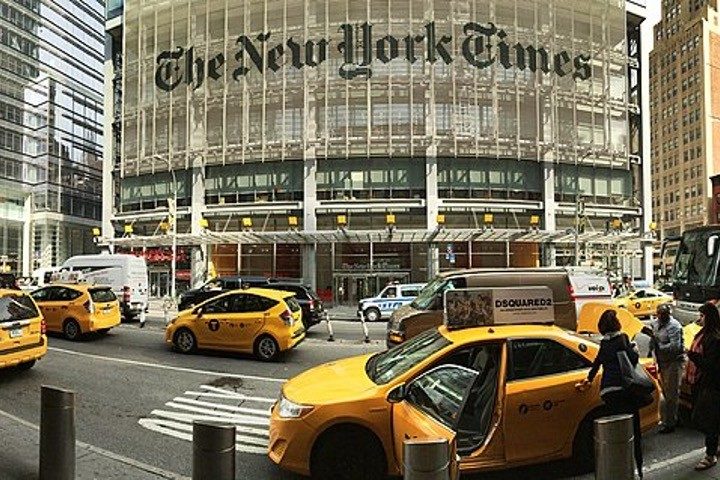
If, for argument’s sake, 90 percent of a certain crime’s perpetrators are of a given group and 90 percent of those arrested for the crime are of that group, you might call that probability. The New York Times calls it something else.
Racism.
At issue is a Wednesday Times essay titled “How Britain’s Crackdown on Gangs Disproportionately Targets Young Black Men.” It’s quite long — more than 5,000 words — yet, interestingly, it doesn’t actually explain “how” the crackdown “disproportionately” targets young black men. Rather, it focuses on the case of one particular young black man, an 18-year-old named Ademola Adedeji.
It’s a human-interest story, designed to manipulate people emotionally so that they not only believe Adedeji was targeted because of his race, but then assume likewise about all black men arrested on gang-related charges.
Adedeji — or Mr. Adedeji, as Times writer Miss Selam Gebrekidan calls him (the Times shows respect for everything but the Truth) — ran into problems largely because of what he’d written.
“What connected him to the case [in question], and a major reason he was labeled a gang member, prosecutors said, were six text messages that he had sent when he was 17,” writes Gebrekidan. “Six texts sent within 20 minutes.”
Of course, one text sent within 20 seconds has long been enough to get you in trouble in Britain and in most of the Western world if you run afoul of their “hate speech” laws (and many people have). Yet the Times not only hasn’t ever complained about this much, but has actually endorsed it.
It’s only well into Gebrekidan’s essay that we learn the real reason Adedeji was arrested: He provided the location of an individual his “rap group” — or “gang,” if you believe the authorities — aimed to violently seek vengeance upon. This fact was rendered only after Gebrekidan mentions that Adedeji was school president and rugby team captain, read his siblings bedtime stories, and has dyslexia. It wasn’t explicitly stated if this is proof positive that the law “disproportionately targets young black men” or if such a person couldn’t possibly be guilty of a serious crime (would that be “classism”?). But Adedeji was charged with conspiracy and convicted.
In fairness, Adedeji very well might’ve gotten a raw deal (I mean that. The whole story is here). And if the Times had confined itself to addressing this one case about this one young black man, the paper might have a case. But, of course, the left-wing media’s causes must be far greater than that; the baby must go with the bathwater.
So Gebrekidan writes that Adedeji “fell into the depths of a criminal justice system in Britain that, by several measures, disproportionately prosecutes and jails Black people. Black people are six times more likely to be stopped and searched than white people, and three times more likely to be arrested.” Whether black people are six times more likely to commit violent crime, however, wasn’t mentioned. In fact, the Times’ information is meaningless because it’s given no context at all.
Why, 98 percent of the people arrested in Britain for sex offenses — men — constitute just 49 percent of the population. For that matter, men constitute an inordinate percentage of those arrested and convicted for a host of crimes. Does this point to a systemic-sexism problem in the U.K. and elsewhere?
Of course, Gebrekidan is playing an old song. When there were complaints that approximately 86 percent of those stopped under NYC’s Stop-and-Frisk program were black and Hispanic, then-mayor Michael Bloomberg said that the two groups were under-represented in this statistic. His assertion was sound: In the city, 96 percent of all crime and 98 percent of gun crime were, at the time, committed by blacks and Hispanics.
This said, the Times’ article will likely accomplish its goal, which isn’t to inform but deform (conception of reality). This absolutely has worked with the issue of police shootings of black suspects, after all. Polls show that many people believe that cops kill 100 or more “unarmed black people” yearly, with liberals fancying the number exceeds 1,000. One might think they’d know for sure because, with all the coverage the topic gets and with the problem allegedly being so egregious, the media surely must lead with the actual numbers, right? They don’t, for a simple reason:
The figure is in the range of approximately 12 to 27 a year — in a country 335-million strong. The truth would kill the media’s narrative.
Yet out-of-context racial statistics do suffice upon accepting a certain leftist supposition: the validity of “disparate impact theory.” This essentially states that if groups perform differently under a standard or on a test, that measure is by definition unjustly discriminatory and must be scrapped. This rationalization was used to eliminate police and fire department exams that women (for physical reasons) and minorities were less likely to pass. (It’s why we now occasionally see miniature cops.) It’s the theory the Obama administration applied when demanding, in essence, that schools prescribe suspensions and expulsions based on racial quota. Yet as Professor Thomas Sowell pointed out, unless you believe that a black boy couldn’t possibly misbehave more than an Asian girl, what’s the point?
Of course, don’t expect principle even in this. Disparate impact theory is seldom if ever applied when groups deemed “privileged” are disparately impacted, such as when boys and whites are punished more than, respectively, girls or Asians. What’s more, if you hold your breath waiting for The New York Times to cease its disparate reporting, you’ll turn bluer than any amount of vote fraud could make any once-purple state.



